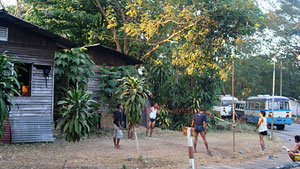December 26-30th, 2006
Yangon, Burma/Myanmar
Memories of Burma/Myanmar
By Lois Joy
Part I
Photos
embedded in this story can also be seen as a larger photo gallery by clicking
here...
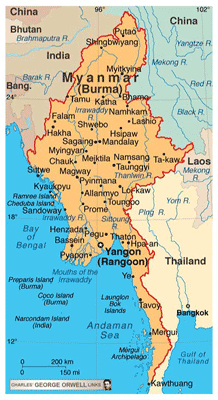
“Kiss softly at first. The surface can be sensuous, sweet and luscious,
but under the surface lurks vicious, needle-sharp danger.” In his book,
“Land of a Thousand Eyes,” Peter Olszewski describes the lush
green-leafed kiss me softly plant that hides one-inch thorns, a perfect analogy
to life in Yangon, Burma. I was intrigued. I had to go there and see it for
myself.
Since I needed to have a stamp in my passport by December 28th, I would have
to leave Phuket, Thailand to make another VISA run. After the dawn-to-dusk
VISA run to Burma the previous month, I knew what I did not want to do: herded
onto a bus to Ranong, Thailand, ferried across the Pak Chan bay to Burma,
dumped into a long immigrations line in the mid-day sun, herded again back
to the ferry with the precious in & out stamp. We saw the crisp $100 bills
changing hands. The twenty-minute Visa, they call it. I’d been there,
done that; there had to be a better way. So I jumped through bureaucratic
hoops to get a legitimate 30-day tourist Visa, stating “retired”
as my occupation. Writers, photographers, and journalists are not welcome
there.
December 26, 0800: As I wait in the lounge of the Phuket airport, my knees
shake with anxiety and trepidation, while my head swells with excitement and
anticipation. I will board a flight to Yangon (previously Rangoon) in less
than an hour. By the end of the day, I will be in a country of river plains
historically hid from the world by rising mesh curtains of misty, mysterious
mountains; a country of intrigue and a long history of bloodshed, “voodoo
socialism,” and repression of the peoples; a place where—in royal
times—princesses were strangled and princes sewn into velvet sacks and
“gently” beaten to death with paddles.
In a chilling precursor to the Tiananmen Square Massacre in China a year later,
hundreds, maybe thousands, of students and protesters were methodically slaughtered
during September of 1988 (see sidebar). After the bloodbath, a new junta was
formed, the State Peace and Development Council (SPDC), which still runs the
country. The rightful head, Aung San Suu Kyi, a beautiful modern day princess
elected by 80% of the populace, languishes under house arrest, where she’s
been for 11 of the last 17 years, since her election in 1990. An elegant women
whom the locals still call “the lady,” she is a perpetual thorn
in the side of the ruling military junta.
Yangon had been a sad symbol of the decline brought about by the dysfunctional
dictatorial regime of General Ne Win. Stories claim that he bathed in dolphin
blood while he turned a once prosperous nation into perhaps the worst economic
disaster of all of Southeast Asia. Yangon is a strange, yet dignified city
that reportedly welcomes tourists. In three weeks, paid hotel receipt in hand,
I was able to get a one-month VISA through Green Travel (located in the hallway,
next to KFC, at Robinson’s in Phuket-Town). Yangon was the capital—and
is still considered the capital by most of the world—but recently the
junta built a new capital in the mountainous jungle of the interior. Perhaps
they feel protected there, but no one wants to follow them into a dismal hibernation.
The embassies are all in Yangon; Thailand has just spent millions of bahts
to complete a new one there.
Yes, I can imagine what you all are thinking. In my story, “Flatlining”
I told you that I’ve had enough of always “living on the edge.”
So why am I traveling to Myanmar—and on my own yet—since Gunter’s
not interested in visiting a repressed country? First, I have an irrepressible
curiosity to find out how people live under a brutally repressive regime.
Second, it’s possible. I have my VISA. Third, I have an implacable writer’s
urge to tell their story. My flight for Bangkok is called. I am on my way.
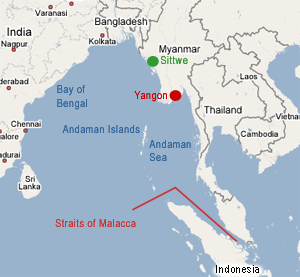
At the new Bangkok Airport, I walk and ride moving sidewalks in modern metallic
tunnels for miles, it seems, until I come to a terminal way at the end of
the hangars for Yangon. I have two hours to wait, but the clerks at the gate
look at my boarding pass and assure me that I am at the right gate. Seated
on the high tech chrome mesh seats, I wonder at the man across from me; he
has such a vacant dullard-like stare. I focus on writing in my journal. The
noise level increases and the seats are filling up. I hear a lot of chatter
that sounds like Chinese. Strange. All of a sudden, most of the group rises
to form a line.
“Why they are all leaving when no flight has been called?” I ask
a smart-looking Asian businessman with an attaché case at his side.
“Oh, they just see the plane on the tarmac and begin to crowd already;
but I’m sitting because all the passengers have to disembark and that
will take some time,” he answers in perfect English.
I look at the plane through the floor-to-ceiling glass. It is not Thai Airways.
I turn to the businessman. “Where are you going?”
“Singapore, of course.”
“But this is the gate D6 for Yangon.”
“This is gate D6, but for Singapore. They could have changed it. Better
check.”
My heart is in my mouth. I rush toward the attendants. “You told me
this was the gate for Yangon when I entered.”
“Now back at Gate D1. Don’t worry; not boarded yet.” I rush
back the long walkway, up and down steps to the first gate, heart pounding
and mouth dry. The lounge is still full of passengers, even though the boarding
time has passed. The sign as I enter says Yangon. I explain why I’m
late. The attendant wonders why I am upset that the new gate was never announced.
“We haven’t boarded yet,” she says calmly and smiles. I
sit down on another chrome mesh chair across from a bored man who is staring
vacantly into space. I recognize him as the man I was sitting across from
at the previous gate. When did he leave and how did he know the gate was changed?
I wonder. Perhaps he’s not retarded, after all! “Better not get
too caught up in my writing,” I warn myself.
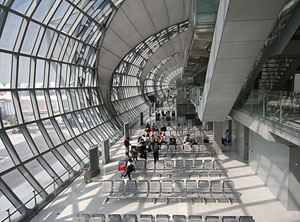
“Welcome to Royal Orchid Service…please place your hand luggage
underneath the seat in front of you…” I am relieved to be finally
seated on Thai Airways Flight 202 to Yangon. I smile at the purple-and-lavender
orchid design of the seats, the deep purple of the carpets and pillows. Orchids,
my favorite flower, along with purple, my favorite color. Good omens. The
slender flight attendants greet the passengers, looking smart in their fuchsia
blouses and pencil-slim purple skirts, wine-and-purple scarves around their
necks, thick dark hair pulled back into buns with pert black bows. After we
take off, one of them greets me with a broad Thai smile and asks me whether
I want red or white wine. I am leaving the familiar Land of Smiles for five
days and entering the Land of a Thousand Eyes, where I haven’t a clue
what to expect. It never ceases to amaze me how one can merely hop on a jet,
rise above the clouds wrapped in a cocoon of steel, and land in a completely
different country and culture.
I sit back and read a Review of 2006 in the Bangkok Post. The new Bangkok
airport opened less than three months ago is already overloaded; they are
talking about using the old one as a commuter terminal. The article lists
a litany of complaints. The September coup is rehashed. In Thailand, a military
junta has also taken control, but that is different than in Burma; they had
to because the duly elected Thaksin administration had become corrupt. And
besides, the junta had the tacit approval of the King! They do plan elections,
perhaps in October of 2007 after the new constitution has been drafted. In
Southeast Asia, I’m finding that democracy has shallow roots.
I go back to reading the Review. In November of 2006, the Bank of Thailand
announced capital controls to stem the rise in its currency, the baht, only
to partially rescind them the following day, after the market dropped 15%,
a record one-day fall for the Thai Stock Exchange. The editorials have not
been kind.
And what will the government-censored Myanmar Times have to say about their
year? Will it be similar to the China and Vietnam censored press, or will
it be even worse?
Lunch is served. I lift up the aluminum foil, expecting a Thai meal. To my
surprise, we have pork roast, spaezle, and green beans with mushrooms for
lunch. This could be Lufthansa! But no, before we disembark, we all receive
an orchid corsage. A cute, elderly Japanese couple shares my row. She says
“tank you” as she attaches the orchid to her floppy hat while
he attaches his to his baseball cap.
Customs is long, hot and involved with three forms to fill out upon arrival.
I pick up my baggage from the lone carousel at the dilapidated airport that
is painted green and gray, like army barracks. My Burmese guide, Stevin, from
Dieter Travel is there to meet me. He has an air-conditioned car and driver.
So far, so good.
We drive to the Dusit Inya Lake Resort, about 10 minutes from the airport
and half-way to downtown Yangon. As in most Southeast Asian resorts, I am
seated in the hotel lounge and offered a juice drink, while a clerk comes
to me to fill in the forms. The outside of the huge hotel is off-white, imposing,
but somewhat austere. Later, I find that it was built by the Russians during
the “socialist” era. The lobby is tastefully furnished in gold
and ecru, with wicker and rattan furniture. It is quite grand, with many conversation
areas, and—surprisingly—a Christmas tree and Gingerbread House
at the entrance to the elevators. I am pleased as punch with my room: spacious,
with a king-size bed, a writing desk, and a seating area facing the TV. Maroon
drapes frame patio doors running the length of the suite, with a billowing
white curtain in the center. A complimentary pint of Mandalay Rum sets on
top of the mini-bar, which contains Myanmar’s own brand of coke and
soft drinks for $1 each. TV stations include a local Myanmar station and a
Japanese station as well as CNN, BBC, ESPN, Discovery, and a movie station
with English movies and/or subtitles. The closet contains slippers and robes
to use and plenty of wooden hangers (not attached to the pole, for a change).
And the bath has a huge six-foot tub.
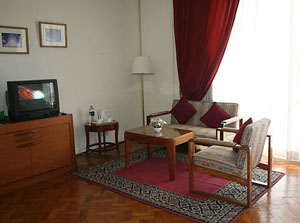
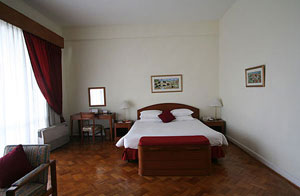
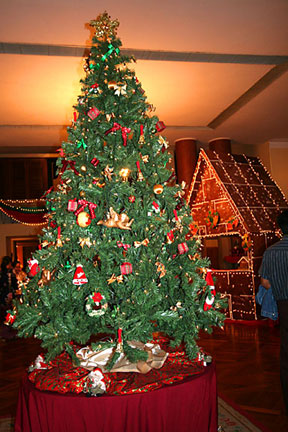
After a late afternoon nap, I take a walk around part of Lake Inya. The hotel
complex is set on 37 acres, and has curving walking paths around part of the
Lake, one leading to a gazebo with a great sunset view. Lake Inya is five
times larger than the popular Lake Kandawgyi, but it is mostly hidden from
view; a walk or drive around the perimeter reveals only that something is
probably on the other side of the earthen berms. The lake stretches Pyay Road
to the west and Kaba Aye Pagoda Road to the east. Certain areas are off limits
to the general public, occupied by state guesthouses and ministerial mansions.
Reportedly, the U.S. is building a new embassy on this lake. Before the reclusive
dictator Ne Win died in 2002, he resided on one end of the lake while Aung
San Suu Kyi resided on the other. For years before his death, Win and Kyi
resided like powerful Nat locked in a battle of wills. “The Lady”
still lives there, at No. 54, under house arrest (see sidebars).
While my thoughts turn to Burma’s tumultuous past, what I see is a bucolic
scene: fishermen on shore and in canoes, rowers from the club across the lake,
birds swooping down for fish. I’m carrying my SLR camera with interchangeable
lens and snap away happily until the sun drops—a deep-orange ball that
doubles on the shimmering surface. I watch the unfolding drama from one of
the teak-and-wicker chairs set on a gazebo along the path, the only person
there. I am at peace. I pray to my God for the people of Burma.
I go to my 5th floor room and then downstairs to eat in the main dining room.
It is quiet and low key, filled with families and couples, half of them western,
the other half Asian. The stairs to the balcony are festooned with green,
gold and red brocade with a small Christmas tree leading up to the stage.
Orchids abound throughout the room. On my table is a centerpiece—an
artificial poinsettia with a red candle. I order from the Burmese section
of the menu; it is similar to Thai, but less spicy.
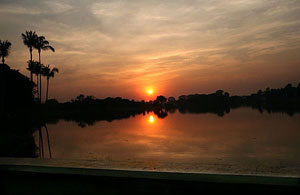
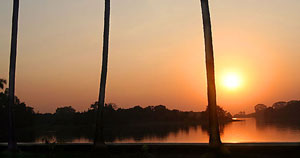
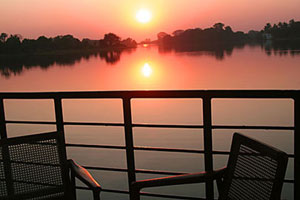
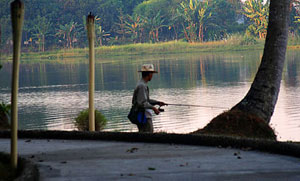
December 27: The City Tour. A buffet breakfast is included with my room.
A white-capped chef expertly flips omelets, next to trays of bacon and sausage,
pan fried potatoes, and an array of fresh fruits and pastry. For the Asians,
there’s rice porridge, noodles and stir-fries. A misty morning view
of Inya Lake greets us. Determined rowers in long canoes criss-cross the lake,
paddles in sync, reminding me of the rowing club at home in San Diego on Sail
Bay.
At 0830, I meet Stevin in the lobby for the city tour. We drive past a street
with white-helmeted soldiers and sawhorse barricades. “That’s
Suu Kyi’s house,” Stevin says. “Don’t point your camera.”
“I am surprised that people are walking through.”
“Yes, they are residents of this street along Lake Inya. When they get
to her house, they have to detour to the next street; they cannot even walk
past.” We talk about her for awhile. “We call her ‘the lady,’
he says. “We all respect and like her very much.”
“How long do you think she will be under house arrest?”
“I think something will happen soon. They are fixing up the front of
her house. Why would they do that if there weren’t going to be some
TV cameras there?”
Rumors abound in Myanmar and hope springs eternal.
Farther along, I do stick my telephoto out the van window to catch a group
of monks going out on their morning alms rounds. There are as many as 500,000
monks in Myanmar and over 50,000 monastic communities, called kyaung. Every
Myanmar male is expected to takes up temporary monastic residence twice in
his life: once as a samanera (novice monk) between the ages of 10 and 20,
and again as an hpongyi (fully ordained monk) sometime after the age of 20.
“This isn’t always followed here in the city, says Stevin. Many
of these boys you see here are from the countryside. Their families have great
merit and prestige when their sons take up the robe and the bowl.”
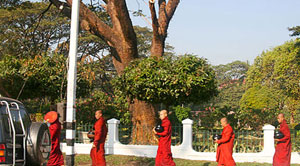
Everything a monk owns must be offered up by the lay community. Every morning
you see them out on the streets to collect their alms (food) which must be
eaten on that day. Upon ordination, a monk is offered three robes: lower,
inner and outer. In Myanmar, the robes are maroon; in other countries, they
tend toward orange or saffron. A monk is allowed to possess a razor, a cup,
a filter (for keeping insects out of the drinking water), an umbrella, and
an alms bowl.
A few minutes later, we arrived at the famous Schwedagon Paya, as much as
a must-see in Yangon as the Eiffel Tower of Paris and the Statue of Liberty
in New York. But unlike the monuments of those western cities, claims the
Lonely Planet, Myanmar, the majority of the pilgrims are locals, and its meaning
is deeply religious; it proudly stands for the ancient and timeless. It amazed
me how entwined this magnificent holy place is in the hustle and bustle of
the city, its great golden stupa dominating the skyline from every high place.
Rudyard Kipling called this great bell-shaped temple “a golden mystery…a
beautiful winking wonder.” The temple is the most sacred of all the
Buddhist sites in the country, one which all Burmese hope to visit at least
once in their lifetime. The great golden dome rises 98 meters above its base.
According to legend, the stupa is 2500 years old, but archeologists suggest
that it was built sometime between the 6th and 10th centuries. With numerous
earthquakes, its current form dates back to 1769.
“It contains 60 tons of gold,” says Stevin as we enter. More is
being added every year by pilgrims who purchase a sheet of gold leaf and add
more to the base. I did the same. It becomes sort of a rite of passage.
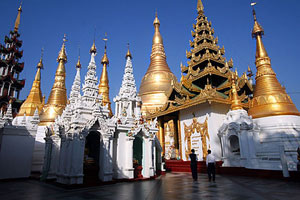
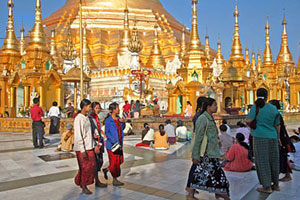
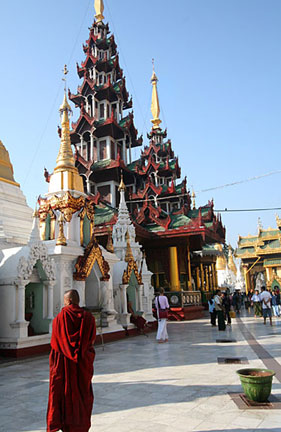
As I walk through the Paya, I watch the worshippers, the many flowers and other offerings placed at various Buddhas and other statues. The brightness of the rising sun on the gold is awesome!
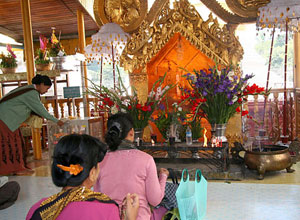
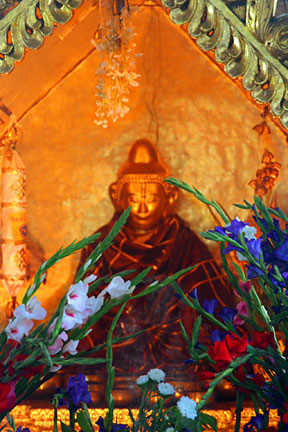
I come across a nun who is bowing to the ground many times. “Wait and
watch,” says Stevin. “After praying for her wishes to be granted,
she will lift this stone, which will become light as a feather.” I motion
to her, asking permission to take photos. She nods her assent. Then I silently
wait, as she bows, prays, and then lifts the stone.
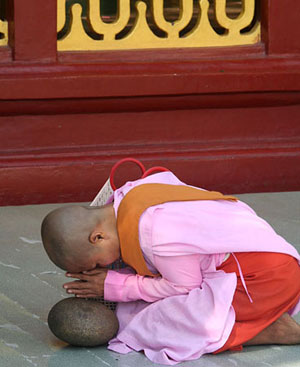
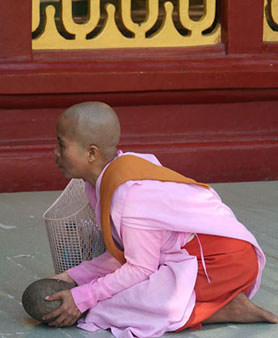
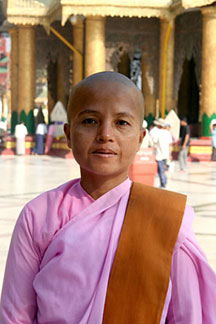
In Myanmar, the women who live the monastic life as dasasila (10-precept
nuns) are often called thilashin (possessors of morality). They shave their
heads, as the nun in this photo, and wear pink robes, and take similar vows
upon ordination. Nunhood isn’t considered as prestigious as monkhood,
mainly because nuns do not perform ceremonies and they keep only 10 precepts,
the number observed by male novices.
Gaining my courage, I ask a young novice to pose for me as well. Then I decide
to add some more gold to the Paya. So I purchase a paper of gold leaf and
apply it to one of the many Buddha statues. After that, we see yet another
Buddha, this one reclining with smaller attendant Buddhas around it. As I
leave the grounds, I take another look at the very top of the stupa. It glows
golden against the deep blue of the sky, a wonderful heritage for the Burmese
people.
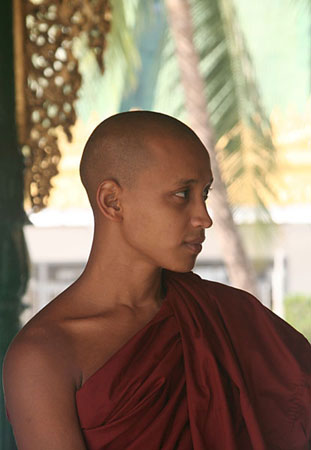
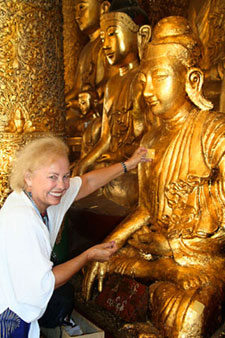
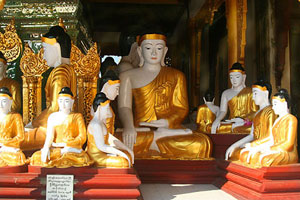
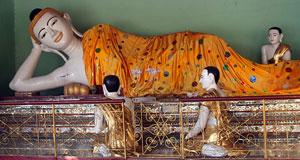
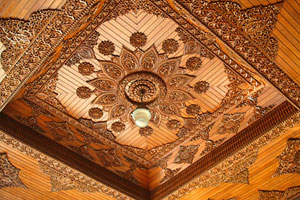
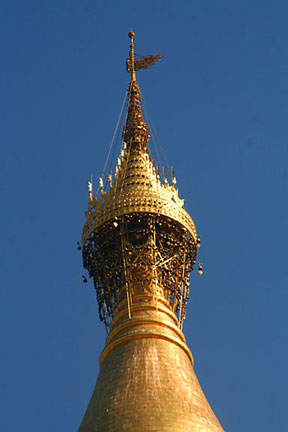
Next, we drive to the Chaukhtatgyi Paya. We enter a large, metal roofed shed, not that attractive, but the inside is worth seeing: a huge reclining Buddha almost as enormous as the one in Bago, but not as well known. On some days, fortune tellers on the surrounding platform offer astrological and palm readings. What amazed me were the huge feet at the narrow end of the figure, replete with what must have been an early type of reflexology.
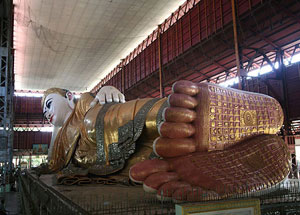
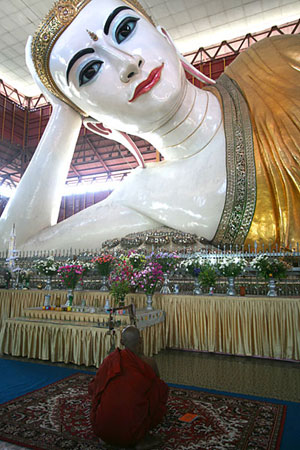
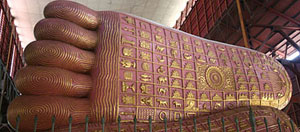
At a viewpoint from the park along the eastern shore of Kandawgyi (Royal Lake), I take a photo of a reinforced concrete reproduction of the Royal Barge. Called the Karaweik (Sanskrit for garuda)—the legendary bird-mount of the Hindu god Vishnu—many of the locals deride it as a monstrous creation of the government, but it has become an attraction in its own right.
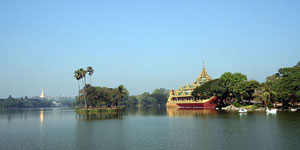
Our next stop: the National Museum, established in 1952, but never opened
until 1996. It is an imposing five-story building with 200,000 square feet
of exhibit space. Cavernous and not well labeled, it is somewhat drab and
depressing. The government could well put some money into it, for it is filled
with wonderful treasures of the Burmese. The 8-meter high Lion Throne of the
last Burmese king is most impressive, about 150 years old, made of Yamanay
wood and gilded in gold. Taken to Kolkata for display there, it was returned
to Myanmar upon its independence in 1948. There is quite a bit of other royal
regalia, plundered by the British but returned. “You’ll find the
best of the Burmese collection still in the U.K, in London’s Victoria
and Albert Museum,” says Stevin. Examples of Burmese 19th century woodcarving,
archeological finds, old maps, and a display of traditional musical instruments
fill the upper floors. Wonderful oil paintings hang on bare plaster walls
in semi-darkness. The fourth floor, called the “Showroom for the Culture
of National Races” was most interesting; about 40 mannequins are dressed
in the various ethnic groups of the country.
Officially, the population of Myanmar (not including Chinese, Nepalese, Indian
and other groups) is divided into eight nationalities—the Bamar (Burmese)
Shan, Mon, Kayin, Kayah, Chin, Kachin and Rakhaing—but the government
then divides these into 67 subgroups. The Burmese make up 68% of the country,
and not surprisingly, are the rulers. From the top military generals to the
tri-shaw drivers, the Burmese believe that being Buddhist is a key aspect
of being Burmese, so the Myanmar media reports daily on the merit making of
top officials who visit the country’s Buddhist places of worship. The
Burmese language is the language of instruction in all schools. Non-Bamars
speak Burmese as a second language.
The sarongs, turbans, and other ethnic styles of dress are prevalent—
even on the streets of Yangon. For example, most men wear longyi (sarong-like
lower garments); only the boys tend to wear t-shirts and slacks or jeans.
The Chin State borders India and Bangladesh. Their women wear poncho-like
garments woven with intricate geometric patterns. Their tattoos are amazing;
they cover most of the face, starting just above the bridge of the nose and
radiating out like a spider web. Even the eyelids are tattooed. The Kachin
have mostly adopted western clothes that adapt to harsh seasonal extremes,
but the men’s longyi is a colorful indigo, green, and deep-purple plaid.
During festivals, the women wear finely woven diamond-patterned skirts and
dark blouses festooned with silver medallions and tassels. The Kayah (Red
Karen) settled in a mountainous area that is completely closed off to travelers.
A significant number now live in Thailand’s Mae Hong Son province. The
Kayin (also known as Karen) are 7% of the population of Myanmar, but they
are divided into numerous subgroups, and therefore, do not achieve the cohesion
needed for political clout. Some are Christian and others, Buddhist. Both
men and women wear longyi with horizontal stripes. The Mon were one of the
early inhabitants of Myanmar and their rule stretched into what is now Thailand.
They were gradually conquered by neighboring kingdoms. During the pre-colonial
period, Mon Buddhist sites—including Yangon’s Schwedagon Paya—were
appropriated by the Bamar, who also borrowed their taste in art and architecture.
The Naga are settled mostly in the mountainous region of eastern India known
as Nagaland, but some also live on the Myanmar side of the border. When the
British arrived in the 19th century, the Naga were a fearsome collection of
tribes practicing headhunting and for many decades, they managed to resist
British rule. During WWI, the British recruited 17,000 of these warriors to
fight in Europe, which created a feeling of camaraderie, uniting these tribes
into an independence movement. During festivals, the men wear ceremonial headdresses
made up of feathers, tufts of hair and cowry shells, and carry wicked spears—a
fierce look that is African, Amazonian, and Polynesian all rolled into one.
The Rakhaing, in a state bordering Bangladesh—are a “Creole”
race—a mixture of Bamar and Indian—and have borrowed culture from
the Indian subcontinent. Most are Buddhist; a minority are Muslims. Skilled
weavers, their longyi are intricate and eye-catching. The Shan (a Bamar word
derived from Siam) call themselves Tai, and in fact, are related to the Thai
populations in neighboring Thailand, Laos and China’s Yunnan province.
At one time, they fought the Bamar for control. Today, they make up 9% of
the population. Traditionally, they wore baggy trousers and floppy, wide-brimmed
sun hats, but now the town-dwellers dress in longyi. Shan women are admired
throughout Myanmar for their beauty and light complexions.
You may have heard of the ‘wild wa’ as headhunters in books about
British colonial days. The Wa decorated their villages with the severed heads
of vanquished enemies to placate the spirits that guarded their opium fields.
(Apparently, they only stopped the practice in the 1970s.) The upper Salween
River in northern Shan State was never completely pacified by the British.
Nowadays rumors abound of the 20,000-strong United Wa State Army, supposedly
highly militarized producers of opium and methamphetamine. They often make
headlines in neighboring Thailand, due to border skirmishes.
We leave the museum early afternoon. I have absorbed what I can; now all I
can think about is food.
Stevin told me yesterday that he would be my “banker” until we
could exchange money on the black market. Before lunch, he makes his transaction.
The black market rate through contacts at the restaurant is 1,200 kyat (pronounced
chat) to one U.S. dollar. If we had searched out a money changer downtown,
we could have obtained today’s rate of 1,079 kyat. “I never can
understand how it works,” says Stevin, but the ‘going rate’
changes daily. There are three rates here in Yangon,” he explains, “the
government rate—which no-one uses unless they have to—7 kyat to
the dollar; the official rate, 450 kyat; and then the black market rate. Don’t
change over $20 at a time. In most places, you can use American dollars.”
Our waitress brought my kyat in a beautiful lacquered jar.

As we consume rice with chicken and vegetables—not as spicy as Thai—Stevin
explains more of the strange financial machinations that the Burmese face.
For example, the government discourages long distance calls by charging $1,500
for a Myanmar SIM card for a cell phone, available to officials only; on the
black market, they cost $3,500. “How do you manage?” I ask. “I
see you using one.”
“I have to, for my business, so I rent one from the military for $50
per month. An international call is about $5 per minute additional, but a
local call is only 15 kyat.”
On the way back to our hotel, we stop at a gas station and I learn more: the
petrol through the government is 30 octane; Stevin buys 90 octane, which runs
better. It is $2.75 per gallon. His ‘90s vintage Toyota Corolla cost
him $40,000. The 2004 Nissan Ultima I own could be imported for about $70,000-$100,000.
A 2006 would be out of sight. A year 2000, four-wheel drive Land cruiser would
cost about $400,000. Stevin points out WWII vintage trucks still on the road.
“Everyone who manages to buy a car here becomes a mechanic because there
are very few parts and as you can see, our cars are very old. Expensive, because
of the high import tax. Even so, new cars can be obtained. I have seen a government
official in a $250,000 Mercedes Benz.”
He goes on to inform me that there are no motorcycles allowed in the city
of Yangon, because of the government’s fear of snipers. “I thought
the top guys moved to a new capital in the interior.”
“There are still plenty of them here in the city. They think it is easy
to shoot from a motorcycle.” Yangon is so different from Hanoi or Saigon,
where the cycles gather at stoplights en masse. Here the residents here mostly
walk or use pedicabs, peddle-driven side carts.
“How many military total?” I ask Stevin.
“About 400,000. That’s a lot for a population of 60 million. About
11-12% of the population of Myanmar live here in Yangon. 70% of the Burmese
live off agriculture. Because business is so difficult here, there are not
that many jobs available for them in the city.”
“So this country is not so crowded then.”
“About 70 people per square mile, compared to 940 in neighboring Bangladesh—only
Yangon and Mandalay have lots of people.”
I’m happy to go back to my room to digest all that I’ve seen and
heard. I turn on BBC to catch up on the world news. Then, my head in a daze,
I take a nap before going out again to explore the area around the hotel.
I pass by a group of boys playing a game similar to volleyball but with a
smaller ball that they kick around or hit with their heads. Later, I check
it out in Lonely Planet Burma. The game is chinlon, called “cane ball”
in Burmese English. The ball is 12cm in diameter, made of woven rattan. In
the casual version, any number of players can form a circle and keep the chinlon
airborne by kicking it soccer style from player to player; there is no scoring.
In formal play, six players stand in a circle with a 22-foot circumference.
Each player must keep the ball in the air using a succession of 30 techniques
and 6 surfaces on the foot and leg, allowing five minutes for each part. Each
successful kick scores a point, while points are subtracted for using the
wrong body part or dropping the ball. The version I watched, using the net,
uses the same rules as in volleyball, but only the feet and head are allowed
to touch the ball.
I head toward the Lake Inya path again; this time I’m using my telephoto
lens. I sit in the gazebo to watch the golden orb disappear into the lake.
An army band from the base nearby plays a Burmese version of taps.
